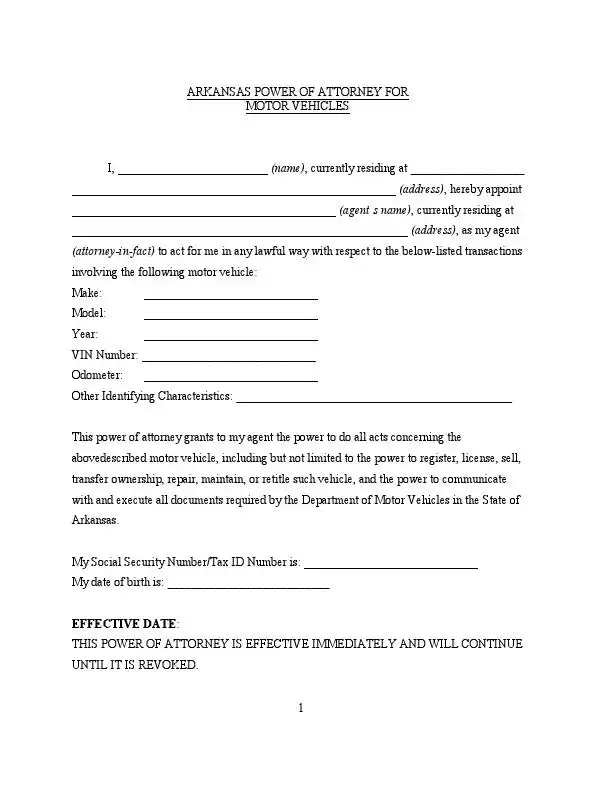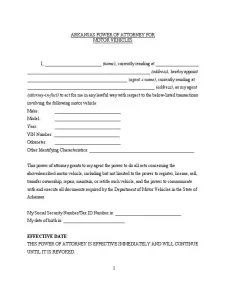Arkansas Motor Vehicle Power of Attorney Form
The Arkansas motor vehicle power of attorney is a legal document that allows an individual (the principal) to authorize another person (the agent) to handle vehicle-related matters on their behalf. This may include registering, titling, or selling the vehicle. Adhering to the state’s specific signing requirements and laws is essential to ensure the power of attorney legality and enforceability.

Build Your Document
Answer a few simple questions to make your document in minutes
Save and Print
Save progress and finish on any device, download and print anytime
Sign and Use
Your valid, lawyer-approved document is ready
Under Arkansas law, specifically Ark. Code Ann. § 28-68-105, the power of attorney form must be signed by the principal and notarized to verify its authenticity. Without notarization, the Arkansas Department of Finance and Administration may not accept the document, which oversees vehicle registration and titling. Key requirements for the Arkansas motor vehicle power of attorney form include:
- Principal’s information. The principal’s full name, address, and contact information.
- Agent’s information. The agent’s full name, address, and contact information.
- Vehicle Information. Details of the vehicle, such as make, model, year, VIN, and title number.
- Scope of authority. Specific powers granted to the agent, such as registering, titling, or selling the vehicle.
- Notarization. The principal’s signature must be notarized.
Additionally, the document should explicitly state the effective date and duration of the authority granted. The principal can revoke the power of attorney by giving the agent and relevant authorities written notice.
You can also refer to Arkansas power of attorney forms for more detailed information and to obtain the necessary forms. It is crucial to follow these guidelines closely to avoid legal complications or document rejection by the state authorities.
Arkansas Motor Vehicle Power of Attorney Form Details
| Document Name | Arkansas Motor Vehicle Power of Attorney Form |
| State Form Name | Power of Attorney for Vehicle Transactions |
| Relevant Link | Arkansas Division of Motor Vehicles |
| Avg. Time to Fill Out | 10 minutes |
| # of Fillable Fields | 18 |
| Available Formats | Adobe PDF |
Filling Out Arkansas Vehicle POA
The Arkansas Power of Attorney for Vehicle Transactions authorizes another person to handle vehicle transactions on your behalf. This includes tasks like applying for a duplicate title or picking up a title. Follow these steps to complete the form accurately.
1. Principal’s Information
Start by entering the full name of the person granting the power of attorney (the principal) in the space at the top of the form.
2. Agent’s Information
Enter the full name of the person appointed as the attorney-in-fact (the agent) in the designated space next to “do hereby appoint.”
3. Business Information (If Applicable)
If the agent represents a business or title service, fill in the name of the business or title service in the provided field below the agent’s name.
4. Address Details
Provide the complete address of the principal, including the street address, city, state, and zip code. Repeat this for the agent if required.
5. Vehicle Information
Enter the vehicle details, including the year, make, model, body type, and Vehicle Identification Number (VIN). If more than one vehicle is involved, a separate form must be completed for each vehicle.
6. Type of Principal
Check the appropriate box to indicate whether the principal is an individual or a business. If it’s a business, write the business name in the space provided.
7. Signatures and Contact Information
The principal must sign and print their name in the spaces labeled “Signature of Individual or Business Owner” and “Printed Name of Individual or Business Owner.” Also, provide the principal’s physical street address, city, state, zip code, telephone number, and email address. Enter the date the form is being completed in the space at the bottom.
8. Notarization
A licensed notary public must notarize the form. The notary will confirm the principal’s identity and witness the document’s signing. They will also check the documents used for verification, such as a driver’s license, birth certificate, state-issued ID, military ID, or passport.
